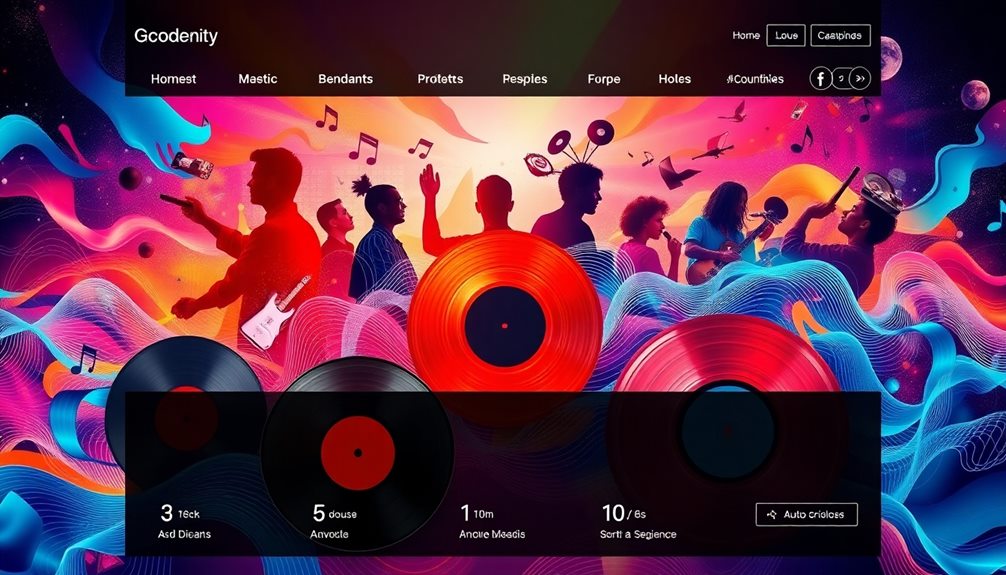To pitch Spotify editorial playlists without a PR team, first understand how curators select tracks by ensuring your music is high-quality, well-tagged, and fits the playlist themes. Research relevant playlists and tailor your pitch by personalizing it, highlighting what makes your song unique, and showing you understand the curator’s style. Promote your music on social media and build relationships with followers and contacts. Keep following up thoughtfully—there’s more to optimize your success for those who look deeper.
Key Takeaways
- Research relevant playlists and curators to personalize your pitch, demonstrating understanding of their style and audience.
- Craft concise, tailored pitches highlighting your song’s fit, unique qualities, and the story behind your music.
- Ensure your track’s metadata, artwork, and audio quality meet Spotify’s submission standards for better chances.
- Engage with curators through social media or playlist comments to build relationships before pitching.
- Follow submission guidelines carefully, and politely follow up with updates or new releases to maintain contact.
Understand Spotify’s Editorial Curation Process

To effectively pitch your playlist to Spotify, understanding how their editorial curation process works is essential. Spotify’s editors select playlists based on various factors, including song quality, relevance, and listener engagement. They prioritize fresh, trending, and unique tracks that resonate with specific audiences. Spotify also uses algorithms to identify popular songs and emerging artists, helping editors discover new music. Keep in mind that playlists are curated with a specific theme or mood in mind, so your music must align with the playlist’s vibe. Additionally, understanding content curation practices can help you craft more compelling and targeted pitches. Recognizing the importance of color accuracy can also influence how your tracks are perceived in visual branding associated with your music. Editors review submissions carefully, considering how your track fits within their curated context. By understanding these criteria, you can tailor your pitches to better match what Spotify’s editors seek, increasing your chances of getting featured.
Prepare Your Music and Metadata for Submission

Before submitting your music, make sure your track metadata is accurate and complete, as it helps curators find and understand your song. Use clear, eye-catching artwork that represents your music well, and confirm your recordings are of high quality to make a strong impression. Properly preparing these elements can substantially improve your chances of getting noticed on Spotify. Additionally, ensuring your resources and tools are up-to-date can give you an edge in optimizing your submission. Be aware of support hours and other relevant schedules to plan your release strategy effectively. Paying attention to your well-being and maintaining a balanced approach can also help you stay focused and motivated during the submission process.
Optimize Track Metadata
Optimizing your track metadata is essential to make certain your music gets noticed on Spotify. Clear, accurate metadata helps algorithms categorize your track and ensures it reaches the right listeners. Use consistent artist names, accurate release dates, and detailed genre tags. Include relevant keywords in your track title and description to improve discoverability. Proper metadata also impacts playlist placements and search results. Focus on these key areas:
| Aspect | Tips |
|---|---|
| Artist Name | Use the same spelling across all releases |
| Track Title | Make it descriptive but concise |
| Genre & Tags | Select specific genres and relevant keywords |
Accurate metadata streamlines discovery, increasing your chances of playlist placement. Incorporating effective yoga practices into your routine can also help boost your mental clarity and focus, which may improve your overall approach to music promotion. Additionally, understanding playlist algorithms can guide you in tailoring your metadata to align with what curators and algorithms prioritize. Staying informed about AI in Education can also inspire innovative ways to analyze and optimize your music marketing strategies.
Use Clear Artwork
Have you ever noticed how eye-catching artwork can make a track stand out on Spotify? Clear, high-quality artwork grabs attention and communicates your music’s vibe instantly. To ensure your artwork makes an impact, keep these points in mind:
- Use high-resolution images (at least 3000 x 3000 pixels)
- Stick to square dimensions for consistency
- Avoid cluttered or busy designs
- Keep text minimal and easily readable
- Design principles can help create visually appealing cover art that draws listeners in.
Your artwork should reflect your music’s style and mood, helping curators and listeners quickly understand your brand. Clear visuals make your submission more professional and appealing. Remember, Spotify’s algorithms favor artwork that’s sharp and well-designed, so invest time in creating visuals that are both captivating and accurate representations of your music. Additionally, artwork specifications are important to meet Spotify’s submission guidelines and ensure your cover art displays correctly across all devices.
Ensure Quality Recordings
To make sure your music makes a strong impression on Spotify, you need to start with high-quality recordings and accurate metadata. Guarantee your tracks are professionally mixed and mastered so they sound clear and balanced across all devices. Avoid low-resolution files or overly loud, distorted audio, as these can hurt your chances of playlist placement. Double-check your metadata—accurate song titles, artist names, and album details—to prevent confusion or rejection. Consistent metadata helps curators find and evaluate your music easily. Also, include relevant genre tags and release dates. Well-prepared recordings and precise metadata demonstrate professionalism, increasing your chances of catching a curator’s eye and landing a coveted playlist spot.
Identify Relevant Playlists and Curators

Finding the right playlists and curators begins with thorough research. You need to discover playlists that match your genre, style, and target audience. Start by exploring Spotify’s search feature, genre-specific playlists, and popular curators. Look for playlists with engaged followers and active curators. Use these tips:
- Check playlist descriptions for relevance to your music
- Analyze the curator’s other playlists and activity
- Follow playlists similar to your genre for updates
- Note the playlist’s submission guidelines and preferences
- Consider the juice detox benefits and ingredients to understand how curated content can boost your exposure and engagement. Additionally, researching the environmental considerations of playlist curation can help you identify those that align with sustainable and community-focused initiatives, increasing your chances of being featured by like-minded curators. Paying attention to the audience engagement metrics can further refine your targeting, ensuring your music reaches the most receptive listeners.
Craft a Persuasive and Personalized Pitch

To catch a curator’s attention, craft a message that’s both personalized and compelling. Focus on highlighting what makes your music unique and relevant to their playlist. Keep your pitch clear and concise to make a strong impression quickly. Incorporating insights about professional music promotion can also increase your chances of success.
Personalize Your Message
Crafting a personalized pitch is essential because playlist curators receive countless submissions daily. To stand out, show you’ve done your homework. Address the curator by name if possible, and mention specific playlists you admire. Highlight how your music fits their style, referencing particular tracks or themes. Keep your message concise and genuine—avoid generic templates. Focus on building a connection that demonstrates you understand their audience. Use these tips to personalize effectively:
- Mention why your music aligns with their playlist’s vibe
- Reference recent playlist updates or curatorial choices
- Share brief stories behind your song’s inspiration
- Show familiarity with their curatorial approach and values
- Demonstrate your understanding of inspirational quotes about fatherhood and how they relate to your message
- Incorporate insights about their company values to show alignment and understanding of their broader mission
- Additionally, understanding the impact of curated playlists on listener engagement can help you tailor your pitch to resonate more effectively with curators.
- Recognizing how creative practice influences the curation process can further enhance your approach by showcasing your dedication and authenticity.
Highlight Unique Qualities
What sets your music apart can make all the difference when pitching to playlists. Highlighting your unique qualities helps your song stand out in a crowded inbox. Think about what makes your sound different—maybe your lyrical style, a distinctive genre blend, or an emotional core that resonates. Share specific details that showcase your individuality, like the story behind the song or your influences. Avoid generic descriptions; instead, focus on what makes your music fresh and compelling. This helps playlist curators see why your track fits their vibe and why listeners will connect. By emphasizing your unique qualities, you create a persuasive, memorable pitch that invites curators to contemplate your music seriously.
Keep It Concise
A well-crafted pitch should be brief, compelling, and tailored to each playlist curator. Keep your message focused and avoid unnecessary details. Respect their time by getting straight to the point and highlighting why your song fits their playlist. Personalization matters—show you’ve researched their curatorial style and audience. Use clear, direct language to make your pitch stand out.
To keep it concise, include:
- A brief introduction about yourself
- A quick description of your track’s vibe
- Why it suits their playlist
- A polite call to action
This approach ensures your message is memorable and easy to understand, increasing your chances of getting noticed. Remember, curators appreciate pitches that are respectful of their time and clearly relevant.
Leverage Your Existing Network and Social Media Presence

Your existing network and social media platforms are powerful tools for promoting your playlist. Start by sharing your playlist with friends, family, and colleagues who are genuinely interested in your music. Ask them to listen, share, and provide honest feedback. Use your social media accounts to announce new releases, sharing engaging visuals and behind-the-scenes stories to capture attention. Tag relevant artists, influencers, and industry contacts to expand your reach. Participate in conversations and engage with your followers to build a loyal community. Don’t forget to include direct links to your playlist in your bios, posts, and stories. Consistency is key—regular updates and interaction keep your audience engaged and more likely to share your playlist organically.
Follow Up Strategically and Maintain Relationships

Once you’ve shared your playlist and engaged with your audience, maintaining those connections becomes essential. Follow up strategically by sending polite, concise messages to playlist curators or editors, expressing appreciation for their work. Keep the conversation professional but personable, and avoid being pushy. Building genuine relationships helps you stay top of mind for future opportunities. To do this effectively, consider these tips:
- Personalize your follow-ups based on previous interactions
- Share updates or new releases that fit their playlist themes
- Engage with their content on social media authentically
- Maintain consistency without overdoing it
This approach helps you nurture partnerships, increases your chances of playlist inclusion, and solidifies your reputation within the industry.
Frequently Asked Questions
How Often Should I Submit to Spotify Playlists?
You might wonder how often to submit your music to Spotify playlists. To maximize your chances, aim to submit new releases at least 4-6 weeks prior to your launch date. Avoid over-submitting; once every few months is typically enough unless you have multiple releases. Consistency is key, but quality matters more. Keep engaging with playlist curators and make sure your music is polished to increase your likelihood of being featured.
What Are Some Common Mistakes in Pitching?
When you pitch Spotify playlists, avoid common mistakes like sending generic messages or not personalizing your pitch. Don’t spam multiple playlists with the same song, and make sure your music is properly tagged and high quality. Refrain from pitching too frequently, which can annoy curators. Also, skip neglecting your artist profile or social media links—these help build credibility. Being professional and respectful increases your chances of success.
Can Indie Artists Get Playlist Placements Without a PR Team?
Think of your music as a ship sailing through a sea of playlists—you can navigate it yourself. Indie artists definitely can get playlist placements without a PR team. Focus on building genuine connections, optimizing your Spotify profile, and submitting your songs through Spotify for Artists. Consistent engagement and authentic outreach help your music catch the eye of curators, turning your solo voyage into a successful journey with playlist placements.
How Long Does It Typically Take to Get a Response?
You might wonder how long it takes to get a response after pitching your music. Usually, Spotify’s editorial team reviews submissions within one to four weeks. However, response times can vary based on the playlist’s popularity and the volume of submissions. Keep in mind that not every pitch gets a response, so stay patient and consider following up politely if you haven’t heard back after a month.
Are There Tools to Track Playlist Acceptance and Performance?
You can use tools like Spotify for Artists and Chartmetric to track playlist acceptance and performance. These platforms give you real-time data on plays, saves, and audience demographics. By monitoring these metrics regularly, you’ll understand which playlists boost your track. Setting up alerts and dashboards helps you stay informed about your song’s progress, so you can adjust your promotional efforts accordingly and maximize your chances of playlist inclusion.
Conclusion
Just like a skilled storyteller, you can craft your narrative to catch the ears of curators and gain their trust. Think of your pitch as a melody that resonates with their playlist’s vibe—personal, genuine, and memorable. With patience and persistence, you’ll open doors to new audiences, turning your Spotify journey into a symphony of success. Remember, every great playlist started with a single note—yours could be next.









